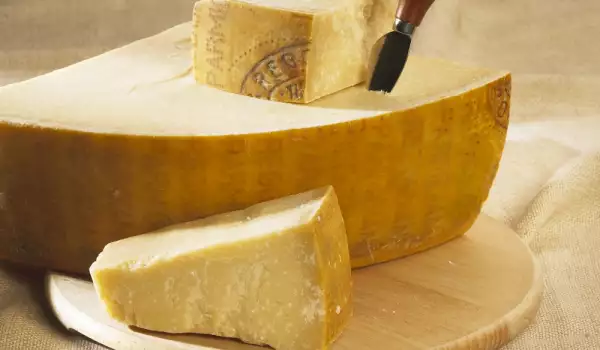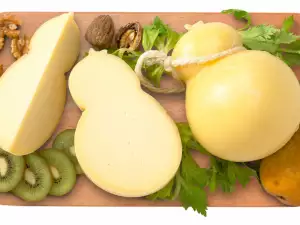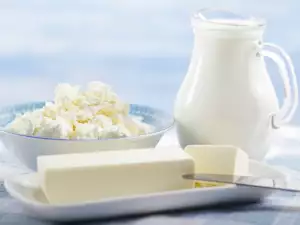Parmesan is the most widely known of hard Italian cheeses. Parmesan actually has been imposed by the Americans and the original Italian cheese with a unique flavor is called Parmigiano-Reggiano. It is named after the area where the modern cheese is prepared in the same recipe - areas near Parma, Reggio Emilia, Modena and Bologna, located in Emilia-Romagna.
Original Parmesan cheese is produced in Lombardy. Parmigiano-Reggiano is deeply rooted in Italian cuisine, but today the whole world is obsessed with its own flavor.
Under European legislation, this cheese has a protected designation of origin under Italian law, only cheese produced in the aforementioned provinces may be labeled "Parmigiano-Reggiano".
Parmigiano is a byword for Italian Parma and "Reggiano" is an endearing name for Reggio Emilia. Under the name Parmesan, this cheese is acknowledged in France and England, but it is a common name often used for cheeses which imitate Parmigiano-Reggiano and are classified as Italian hard cheese.
This somewhat circumvents legal restrictions. Legitimate relative of the original Italian Parmesan cheese is Grana Padano.
Traditionally, Parmesan is made from unpasteurized cow's milk, mixing 2 types of milk - pre skimmed from evening milking and some from morning milking, which adds a completely natural flavor. The unique flavor of Parmesan is rarely wrong, has a sweet and slightly fruity taste and the feel and touch of raisins and pineapple.

History of Parmesan
From time immemorial the region Emilia Romagna produces Parmesan. For recipe authors, some suggest Benedictine monks who made the delicious milk delicacy in their attempts to prepare cheese durability. That, in combination with the unique taste, is the reason for today's cheese being globally popular and widely used.
According to legend, the first Parmesan was established sometime in the medieval village of Bibi, but the quick recipe and production conquered Parma and Modena. Historical documents show that in the 13 and 14th century Parmigiano-Reggiano had been about the same size, shape and taste as today.
Parmesan is mentioned even in the eternal book of Boccaccio - "Decameron": "Mountain of all of the wonderful Parmesan cheese." Even in his memoirs, Casanova talks about real Parmigiano-Reggiano, trying to clarify the longstanding home of its production.
Production of Parmesan
To produce 1 kg Parmigiano-Reggiano, you need 16 liters cow milk. It matures in 36 months. The cakes of still unprepared Parmesan are soaked for about 3 weeks in special solutions. Then it ripens on wooden shelves that are under strict temperature and humidity.
Parmesan matures between one and a half and three years. Depending on the length of maturation, you can distinguish three types of Parmigiano-Reggiano - fresh - within a year and a half, mature - two years older and old - up to three years.
The tasty cheese’s ripening is continuously controlled and monitored by its masters. Large Parmesan cakes are turned periodically, to rub and tenderize it with tiny hammers. The knocking sound shows whether it is good cheese, and if inside there is a cavity, which is not at all desirable.
If they are present, or any of the combs is deemed unfit and substandard, they go for grating and it is sold in ground state. That is why qualitative Parmigiano-Reggiano is sold in whole pieces. Just cut it with a special knife, because standard knives have difficulty cutting these huge delicious cheese cakes.
An average good Parmesan cake weighs around 30-36 kg. A large flat cake is up to half a meter in diameter and up to twenty five centimeters tall. The Parmesan shell is hard and shiny and the color inside the cheese varies from ivory to yellow to orange depending on the degree of maturation. Its texture is slightly grainy, but when it gets in the mouth, the taste is incredible for the palate.

Composition of parmesan
This cheese is full-bodied, containing an abundance of aromatic compounds, such as aldehydes, acids and oils that build aromatic body. Furthermore, Parmigiano-Reggiano is very rich in glutamate, with 100 grams of cheese contains 1.2 glutamate, which ranks Parmesan automatically second, after blue cheeses containing this substance.
It is the high concentration of glutamate is the cause of the so-called. umami taste of cheese, which is one of the five basic tastes together with sweet, sour, bitter and salty.
100 g of Parmesan contains: 392 calories, 22.3 carbs, 25.83 g Fat, 35.75 g Protein, 29.16 g water
Selecting and storing Parmesan
Choose parmesan only from licensed shops. On its container, the date must be clearly mentioned. Keep Parmesan in the fridge, well wrapped in a plastic bag or another container, so as not to dry out.

Culinary uses of Parmesan
To ensure the real taste of quality Parmesan, choose only whole pieces. Grated parmesan is second grade and is not as flavorful as the pieces of cakes. Use the cheese just before the cooking and do not cut it in advance.
Like other aromatic cheeses, it is perfectly combined with fruits such as figs and pears, which is a favorite combination of Italians.
Parmesan is both a main course and dessert cheese. Although simple, a little grated parmesan on bulk rolls or slices of crispy bread can satisfy your taste buds perfectly. Common is the practice of adding Parmesan to different kinds of spaghetti or pasta, lasagna, pizza, baked dishes, sauces and risottos.
Faithful fans of Parmigiano-Reggiano know very well that the crust of Parmesan cheese is a true delicacy that adds rich flavor and great texture to fine food.
If you want to give the Parmesan a more intense flavor, we encourage you to dip a little piece of cheese in quality balsamic vinegar. It is a loyal friend of red wine. This Italian cheese fits very well and most powerful Chianti red wines such as Cabernet Sauvignon, Pinot Noir, Red Bordeaux, Cabernet Franc, Merlot, Rioja, Chianti Classico, Ribera del Duero, Zinfandel and more.




















